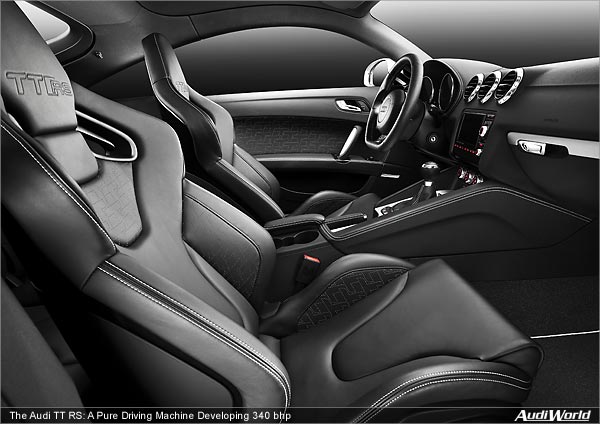March 3, 2009
Source: Audi AG
The Audi TT RS: A Pure Driving Machine developing 340 bhp
Audi is once again producing a five-cylinder engine and a very special one
at that. Arriving at dealerships this summer (Germany), the TT RS has a
turbocharged 2.5-liter engine with direct gasoline injection; it produces 250
kW (340 bhp) and 450 Nm (331.90 lb.-ft.) of torque. The blazing five-cylinder
engine enables the TT RS to perform extraordinary feats. In conjunction
with quattro permanent all-wheel drive and a high-performance chassis, the
engine makes the compact Audi TT RS a top-notch sports car available as a
coupé or roadster.
Sporty five-cylinder gasoline engines have a long legacy at Audi. The most
famous is arguably the turbocharged 2.1-liter engine in the Audi quattro. The first
version, which was launched in 1980, offered an impressive 147 kW (200 bhp).
And the Sport quattro from 1984, directly inspired by motorsport, delivered a
whopping 225 kW (306 bhp). For 25 years, turbochargers and quattro have been a
dynamic formula for success.
Audi has resumed using this recipe. Designed from scratch, the five-cylinder
engine combines a turbocharger with FSI direct gasoline injection to elevate the
TT RS to a high-performance sports car. The TFSI delivers 250 kW (340 bhp)
from a displacement of 2,480 cc (151.34 cu in): a specific output of 100.8 kW
(137.1 bhp) per liter.
The power-to-weight ratio is also outstanding. In the case of the Coupé, which
weighs in at a mere 1,450 kilograms (3,196.70 pounds), the power-to-weight ratio
is just 4.3 kilograms per bhp. The Roadster has a weight of 1,510 kilograms
(3,328.98 pounds) and a power-to-weight ratio of 4.4 kilograms per bhp thanks
to its extremely lightweight and largely aluminum body constructed as per the
Audi Space Frame principle.
The TT RS Coupé rockets from 0 to 100 km/h (0 to 62.14 mph) in 4.6 seconds;
the Roadster needs just a tenth of a second longer. The limited top speed of 250
km/h (155.34 mph) is merely the official figure for both versions; as an option,
Audi can increase it to 280 km/h (173.98 mph).
Almost even more impressive is the aggressive pulling power. The maximum
torque of 450 Nm (331.90 lb.-ft.) is always available between 1,600 and
5,300 rpm. In addition, the TT RS overtakes without the slightest effort. Last but
not least, its engine makes passengers skin tingle time and again thanks to its
speedy and powerful response, its inspiring free-revving character, and its
unmistakably guttural tailpipes: five-cylinder classical music by Audi!
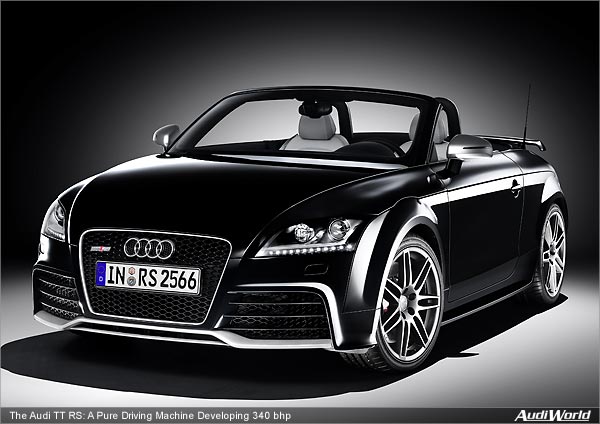
Compact and Lightweight: The Five-cylinder TFSI
As an uncompromising sports-car engine, the 2.5-liter TFSI is ultra-compact. Just
49 centimeters (19.29 inches) in length, it is ideally suited for transverse
installation in the TT RS. And its weight of just 183 kilograms (403.45 pounds)
also sets a record. The crankcase is made of vermicular-graphite cast iron. This
high-tech material unites the utmost in strength with low weight; it has otherwise
only been used for the large TDI engines from Audi. Perfectly placed
reinforcements enhance the blocks loadability. The lightweight cylinder head, the
pistons, and the connecting rod are lightweight as well as high-strength.
The ultra-powerful five-cylinder engine is extremely fuel-efficient, requiring an
average of just 9.2 liters/100 km [25.57 mpg] as regards the Coupé (Roadster:
9.5 l/100 km [24.76 mpg]). Switchable flaps in the intake manifold mix the
incoming air in a calculated configuration. Injected at a pressure as high as
120 bar by the common-rail system, the gasoline swirls intensely in the
combustion chamber which in turn cools the walls. This subsequently facilitates
a compression ratio of 10.0:1, which is very high for a turbocharged engine. Both
of the adjustable camshafts, controlled via chains, also enhance charging
efficiency with respect to the air-fuel mixture.
The large turbocharger generates up to 1.2 bar of boost pressure. The intercooler,
fed air ideally by the lower segment of the single frame radiator grille, reduces the
temperature of compressed air by over 80 percent at full load.
When an Audi TT RS driver pushes the standard Sport button on the center
tunnel, a flap installed in the left exhaust tailpipe renders the exhaust noise even
more robust and intense while boosting engine responsiveness. An optional Sport
exhaust system is available with matt black tailpipe trims and sound flap.
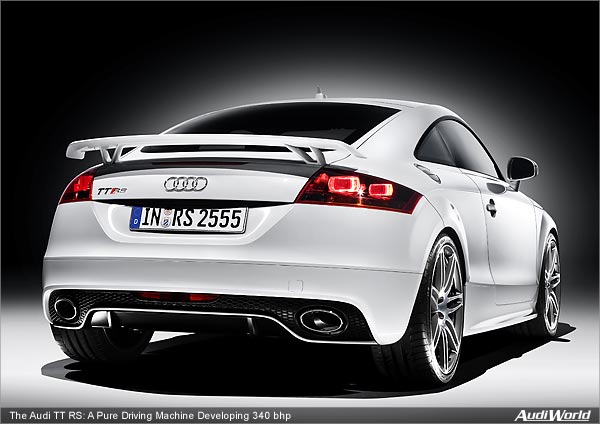
For Purists: The Driveline
The Audi TT RS is the first classic sports car in the Audi RS family. Like the
RS 4 and the RS 6, the Audi TT RS was developed by quattro GmbH as a pure,
no-holds-barred driving machine. A new six-speed manual transmission conveys
the engines tremendous power, and permits easy and precise operation thanks to
a specially designed shift lever boasting particularly short shift travel. The
transmissions defining characteristics are a high efficiency ratio and a sportily
narrow spread of the gear ratios.
The Audi TT RS features quattro permanent all-wheel drive as standard
equipment. Its heart lies at the rear axle: an electronically controlled, hydraulic
multi-plate clutch. If a situation calls for it, the clutch redirects a majority of the
torque input from the front wheels to the rear wheels.
Within milliseconds, a powerful electrical pump in conjunction with an
accumulator presses together the clutchs plates via hydraulic pressure. Additions
to the quattro powertrain include a constant velocity joint before the propeller
shaft and a compact rear-axle differential both are heavy-duty components.
The quattro drivetrain grants the Audi TT RS outstanding traction, fascinating
dynamics, and superb stability. Winding rural routes or some laps around a
racetrack allow the superior handling to shine. The precise and responsive
steering, the instantaneous reactions of the chassis, the neutrality at the cornering
limit, the grip while exiting a curve, and time and again the engines thrilling
power: every mile in an Audi TT RS exudes the distilled essence of sportiness.
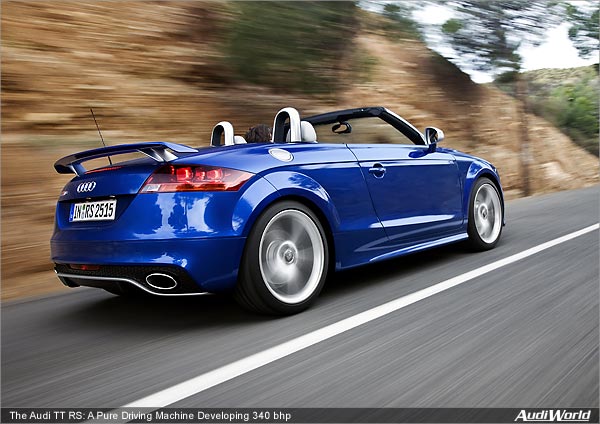
High-tech Excellence from Audi: Chassis and Body
The chassis of the Audi TT RS builds on the cutting-edge foundation of the base
TT design. The four-link rear suspension, which handles longitudinal and lateral
forces separately, plays a crucial role. The electromechanical steering is highly
efficient and the power steering adjusts to the vehicles speed. With aluminum in
the front and sheet steel in the back, the bodys innovative mixture of materials
results in a well-balanced axle-load distribution, excellent crash safety, and the
outstanding rigidity which lays the cornerstone for the cars precise handling.
The standard sports chassis, which lowers the body by 10 millimeters
(0.39 inches), features tightly tuned springs and shock absorbers. The optional
Audi magnetic ride adaptive damping system allows the driver to select one of
two modes for the shock absorbers by simply pushing the Sport button. Dynamic
mode enables the TT RS to hug the road; Comfort mode provides a pleasantly
balanced ride perfect for long journeys.
The sportiest version in the TT model line boasts 18-inch wheels fitted with
245/45 tires. They are complemented by mighty ventilated disc brakes, which
measure 370 millimeters (14.57 inches) in diameter at the front and 310
millimeters (12.20 inches) at the rear. So that heat dissipates quickly, the front
friction rings are perforated. They, in turn, are connected by hollow pins to the
aluminum brake discs, which are encircled by black four-piston brake calipers
made of aluminum and bearing RS logos.
The Electronic Stabilization Program (ESP) can be switched off partially or
entirely. In Sport mode, the engine does not intervene to monitor traction and,
correspondingly, the brakes engage later than otherwise. In the second mode, the
ESP is fully deactivated.
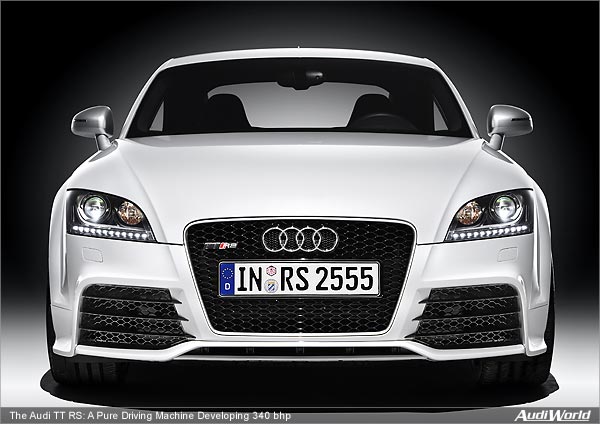
The Face of Power: The Exterior
At just 4.20 meters (13.78 feet) in length, the vigorously compact Audi TT RS
hints at its explosive potential from the very first glimpse. The front spoiler tapers
downward into a splitter, reminiscent of a racing car. The large and squared air
inlets have diamond-shaped inserts. And the high-gloss black single frame grille
with a frame in matt aluminum look and the TT RS badge bear the same styling.
The xenon plus headlights with LED daytime running lights notify faraway
drivers that an Audi TT RS is approaching.
The sides of the vehicle are accentuated by large wheels in 5 twin-spoke design,
vigorous side sills, and exterior-mirror casings in matt aluminum look. At the tail
end, the two large oval exhaust tailpipes spaced apart are encircled by a
diffuser insert. Here, too, is a TT RS badge. A stationary rear spoiler is standard,
though customers can opt for one which automatically extends and retracts.
Thanks to a drag coefficient of just 0.3, the 2+2-seat coupé and the two-seat
roadster glide effortlessly through the wind. Audi offers the TT RS in eight colors.
Among them are four exclusive options: Daytona Gray, pearl effect; Mugello
Blue, pearl effect; Sepang Blue, pearl effect; and Suzuka Gray, metallic. The
Roadsters soft top comes in black or dark gray.
